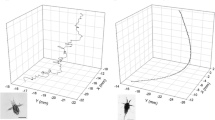Abstract
The zooplankton of lakes and seas consists for the most part of copepods, some species grazing phytoplankton and some living as carnivores, hunting other copepods. Animals of the order Cyclopoida are between 0. 05 and 0. 3 cm long and show a very distinct jerky (hop and sink) swimming pattern, using an average of one powerstroke per second. This gives them a mean speed of 0. 1 to 0. 5 cm/sec so that their Reynolds number ranges from 1 to 50. Storch (1929) filmed the sequence of movements of the four ventrally situated pairs of legs during a powerstroke and found a 4-3-2-1 metachronical pattern. One stroke of all the legs together brings them back to the original position (ventral, front), supposedly leaving the animal with a forward velocity component. The decelerating phase of one hop has been used by Vlymen (1970) to calculate the drag for one copepod species, for which he found the energy expended in swimming to be only 0. 3% of the metabolic energy consumption. In order to avoid an encounter with a predator, Cyclops display an escape reaction, swimming up to 35 cm/sec for about one second. This translates to about 120 powerstrokes per second. In this speed range flapping of the abdomen is more effective (Re ~ 500), but requires more energy.
Access this chapter
Tax calculation will be finalised at checkout
Purchases are for personal use only
Preview
Unable to display preview. Download preview PDF.
Similar content being viewed by others
References
Becker, H. A. 1959 The effects of shape and Reynolds number on drag in the motion of a freely oriented body in an infinite fluid. Can. J. Chem. Eng. 37, 85–91.
Fleminger, A. 1973 Pattern, number, variability, and taxonomic significance of integumental organs (sensilla and glandular pores) in the genus Eucalanus (copepoda, calanoida), Fish Bull. 71, 965–1010.
Gharagozlov-van Ginneken, I. D. and Bouligand, Y. 1973 Ultra-structures tegumentaires chez un crustace copepode Cletocamptus retrogressus, Tissue & Cell, 5, 413–439.
Gray, J. and Lis smann, H. W. 1964 The locomotion of nematodes. J. Exp. Biol. 41, 135–154.
Hochachka, P. W., Fields, J. and Mustafa, T. 1973 Animal life without oxygen: basic biochemical mechanisms. Amer. Zool. 13, 543–555.
Kaestner, A. 1970 Invertebrate Zoology: Crustacea, Vol. 3. John Wiley & Sons, New York.
Lowndes, A. G. 1935 The swimming and feeding of certain calanoid copepods. Proc. Zool. Soc. London, 687–715.
Rosenthal, H. 1972 Ueber die Geschwindigkeit der Sprungbewegungen bei Cyclops strenuus (copepoda). Int. Revue ges. Hydrobiol. 57, 157–167.
Steele, J. H. 1974 The Structure of Marine Ecosystems. Harvard University Press, Cambridge.
Storch, O. 1929 Die Schwimmbewegung der Copepoden, auf Grund von Mikro-Zeitlupenaufnahmen analysiert. Verh. Dt. Zool. Ges., Zool. Anz. Suppl. 4, 118–129.
Strickler, J. R. 1970 Ueber das Schwimmverhalten von Cyclopoiden bei Verminderungen der Bestrahlungsstaerke. Schweiz. Z. Hydrol. 32, 150–180.
Strickler, J. R. 1974 Intra-and interspecific information among planktonic copepods: I I Receptors. Verh. int. Ver. Limnol. (in preparation).
Strickler, J. R. and Bal, A. K. 1973 Setae of the first antennae of the copepod Cyclops scutifer (Sars): Their structure and importance. Proc. Nat. Acad. Sci. USA. 70, 2656–2659.
Tietjens, O. 1970 Stroemunglehre, Vol. 2. Springer Verlag, New York.
Vlymen, W. J. 1970 Energy expenditure of swimming copepods. Limnol. Oceanogr. 15, 348–356.
Author information
Authors and Affiliations
Editor information
Editors and Affiliations
Rights and permissions
Copyright information
© 1975 Springer Science+Business Media New York
About this chapter
Cite this chapter
Strickler, J.R. (1975). Swimming of Planktonic Cyclops Species (Copepoda, Crustacea): Pattern, Movements and Their Control. In: Wu, T.YT., Brokaw, C.J., Brennen, C. (eds) Swimming and Flying in Nature. Springer, Boston, MA. https://doi.org/10.1007/978-1-4757-1326-8_9
Download citation
DOI: https://doi.org/10.1007/978-1-4757-1326-8_9
Publisher Name: Springer, Boston, MA
Print ISBN: 978-1-4757-1328-2
Online ISBN: 978-1-4757-1326-8
eBook Packages: Springer Book Archive




